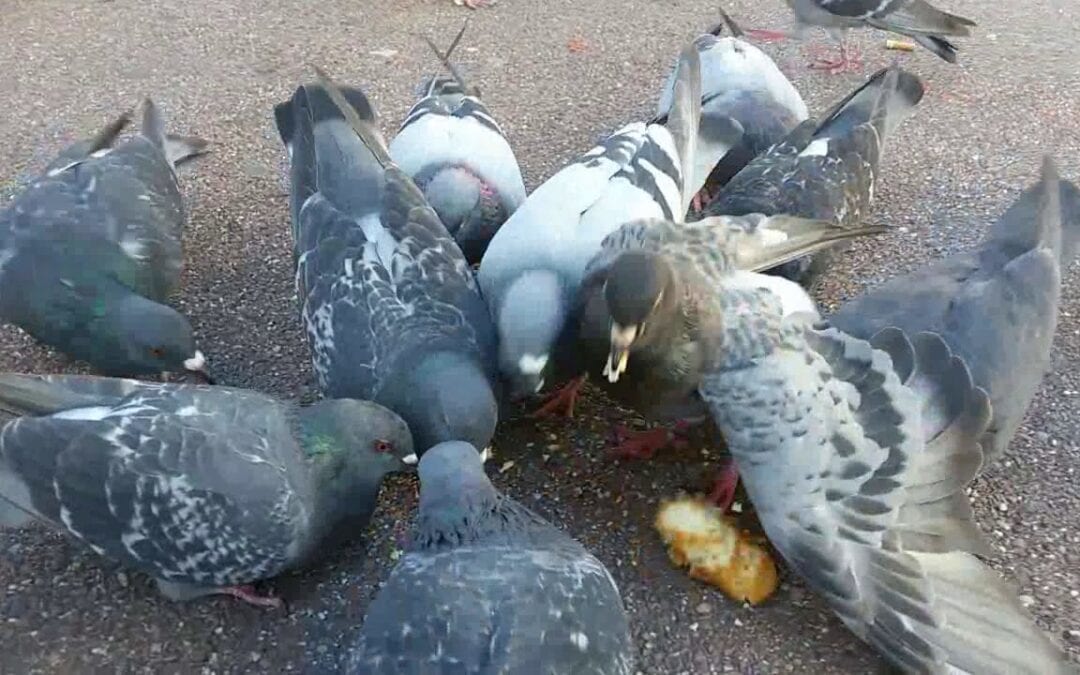
by Pigeon Patrol | Oct 20, 2021 | Pigeon Droppings, Pigeon Patrol's Services, Pigeon Predators, Pigeon Spikes, Pigeons, Pigeons in the News
Pigeons, crows, sparrows, and other birds welcoming you on your porch isn’t a warm greeting. Instead, it will give you headaches due to the smelly droppings and pecking that your porch has endured. And for sure, this situation of your porch isn’t inviting for your future guests. You have to do something and find ways to get rid of birds on the porch before it affects your household and social interaction.
This might sound a bit too much, but birds flocking to your porch sets the image to what your house is from the inside. Remember the trite saying, “first impression lasts”? This is true to some extent because your porch is the first part of your house that people will step into. If it reeks of droppings, it would be an unsightly (and unsanitary) welcome.
But fret not if you’re one of the victims of the notorious bird nesting, dropping, and pecking. There are easy hacks that you can do to send the fowls away. Here are some that you can try at the soonest possible time:
1. REMOVE ANY MATERIALS THAT CAN BE USED AS A NEST
One reason why birds keep flocking on your porch is the presence of materials they use for nest building. Remove dried leaves, twigs, and anything that can be possibly used as a building block of a nesting place. The birds may not intentionally plan to poo on your porch, but it happened otherwise. Try keeping your porch clean of the dried leaves and see if it will have a difference.
Another thing you should check is if your yard tree branches extend near your house’s structure. If yes, chances are this is the reason why the birds keep hanging out on your porch and leaving some unsightly souvenirs. Trim these parts and let the direct light shine into your porch if possible. This will remove the dropping smell after some days as ways to get rid of birds on the porch.
If there’s already a nest on your porch, try calling a wildlife remover to expertly relocate the birds.
2. PLACE A BIRD FEEDER AWAY FROM YOUR PORCH
For once, stop feeding the birds and then complain about the droppings they leave on your porch. Feeding the fowls don’t just make them poop, they also keep them coming back. If the birds still haven’t stopped landing on your doorstep, place a feeder somewhere in your backyard where they can be less invasive. However, this will still leave some bird droppings you’ll have to clean later on.
Some homeowners aren’t worried about getting the hidden parts their yard get dirty as long as the porch stays pristine. To add another diversion to the perching birds, add a birdbath near the feeder so the fowls would be isolated within one area.
Don’t forget to remove any food sources on your porch, otherwise, the birds will also peck on it even in the presence of a separate feeder. That’s one of the crucial ways to get rid of birds on the porch.
3. INSTALL A REPELLENT DEVICE
If all else fails and you don’t have the patience to perform some diversion tactics, go straight to business by installing a bird repellent device. This gadget can either be battery or electricity powered and will emit high-frequency sounds that the birds will find annoying. Upon turning on the device, the birds will fly away due to the unbearable sound only animals can hear.
The only downside here is if you have a roaming cat, the high-frequency sound can also annoy them. Nevertheless, the sound is short-waved and cannot pass through thick walls. Your furball is safe when it’s on another room.
4. SHOW THE SHINY THINGS
In case you have multiple dogs and cats, the ultrasonic device is out of the window. You can explore other means of driving the fowls away. Start by hanging some reflective and shiny stuff on your doorway and the porch itself. You can purchase some of these products online that are all tailored for bird proofing.
When the rods are hit with light, it will sparkle and the reflection will disorient the birds. It will frighten them especially if the rods are moving in a spiraling motion. You can pair it with an owl bird repellent from the same brand for maximum ways to get rid of birds on the porch.
5. MAKE YOUR LIGHT FIXTURES IRRITATING
So there’s no food source on your porch, no trees to extend to your house, and no feeding. What’s the culprit? Your porch light fixture. This part of your porch gives birds enough warmth and a place to nest. It’s actually a perfect place to leave their eggs for hatching because of the heat it emits when in use. But this doesn’t mean you have to remove the light fixture. You just have to make the top part irritating or impossible to land at.
One way to do this is to install appropriate bird spikes to that fixture. Use the excess spikes to bird proof your fence or roof ledge.
6. WIND CHIMES ARE THERE FOR A REASON
Wind chimes are also excellent ways to get rid of birds on the porch. It’s a bird scare due to the sound it produces when it’s hit by a breeze. You can also choose one with shiny chimes to reflect light and discourage birds from landing on your porch.
Wind chimes are good options aside from distress signals since it produces sounds that are pleasant to the ear. The higher the sound produced, the better. You can also come up with a DIY chime using old CDs and other sparkly material.
This method of sending birds away from your porch works on pigeons, brown grass birds, and other smaller fowls.

7. BRING OUT THE OWL
Larger birds like crows and feral pigeons tend to ignore some scare methods. If this happens, you can get an owl replica with haunting eyes to drive them off. This will simulate the presence of a predator which will scare the birds. The trick here is to consistently change the placement of the owl every day so the scare will work as long as it can. Crows are pretty smart birds and they can detect a decoy scare if it doesn’t change positions.
One of the ways to get rid of birds on the porch is the Visual Scare Horned Owl Deterrent. Unlike other owl models, this has moving wings and floating-like feature when mounted on a bar. It has a 44-inch wingspan complete with a simple mechanical system that will allow it to flap if wind-blown. Place this on your porch and even a human will mistake it for a real owl!
8. LET THE CATS TAKE OVER
Nothing beats the presence of a real predator when it comes to sending the birds away from your porch. Letting your cat/s or dogs roam your doorway is a guaranteed way to reduce the droppings and damage the fowls can incur to your house. It also helps to install catwalks on your porch or place a sleeping rug where the cat can cozy up.
You may see some dead birds on the first days when the fowls are yet to discover the hunting threat of your furball. However, the problem arises when the cats get used to the birds that they no longer chase it anymore. This is the reason why you shouldn’t stop using deterrents aside from letting your line of defense wander on the porch.
9. MIRROR, MIRROR ON THE WALL
In case you wouldn’t want to let your pets stay outside, say it’s a rainy day or it’s too hot for the furball, you can place a mirror on it. If you want, you can add glass elements on your doorway as ways to get rid of birds on the porch. Placing small but multiple mirrors on your porch will serve as a reflective method that will annoy the birds. You can place this small mirrors on the sills, so sunlight will directly hit it during the day.
You can also add this to the wall if the light hits on it directly. It works most of the time, but to be sure, it’s best to pair it with other methods and products I mentioned here. Just experiment and you’ll find what works for your porch.
10. SPRAY SOME CITRUSY REPELLENT
Birds hate citrusy fragrances and spraying it on your porch will be an effortless move to annoy them. You make your doorway smell good and you drive away the pesky birds. A double win for you. You can opt for lemon juice diluted in water or purchase a formula specific for repelling birds. But for a natural and non-toxic method, I’ll choose the lemon option especially if there are protected birds visiting your porch.
Just squeeze a lemon and add a little water. Spray it like an air fresher and you have guaranteed ways to get rid of birds on the porch. You can also place slices of lemon on your porch to make the smell stronger. It will also help in fighting off the smell of bird droppings left on your porch after cleaning.

11. MAKE THE SURFACE STICKY
Annoying the birds isn’t difficult. All you have to do is make it difficult for them to land, perch, or roost on a surface. You can install bird spikes for sure but in case the surface won’t allow, a bird gel repellent will save the day.
If you don’t want the birds to get stuck, just apply it thinly on the sills of your porch. Make sure to use a pair of gloves as the gel is really sticky and it can put you in a washing spree if you’re not careful.
12. REMOVE ATTRACTANTS FROM YOUR PORCH
This point is somewhat a summary of all the discussed ideas above. Birds are attracted to your porch for some reasons and it’s your task to identify it and get rid of it fast. If you keep feeding the birds, you’re fueling your problem. Stop this habit and send the birds away with humane methods that won’t kill or harm them.
Before performing the ways to get rid of birds on the porch, remember that some birds like woodpeckers are protected by federal law. You will be fined due to a wrongful death of a bird on your property. Just the right hacks and a little patience will stop the fowls from throwing a feat on your porch. The droppings will soon be over and your doorway will be quiet and free of poop.
Source
Pigeon Patrol Products & Services is the leading manufacturer and distributor of bird deterrent (control) products in Canada. Pigeon Patrol products have solved pest bird problems in industrial, commercial, and residential settings since 2000, by using safe and humane bird deterrents with only bird and animal friendly solutions. At Pigeon Patrol, we manufacture and offer a variety of bird deterrents, ranging from Ultra-flex Bird Spikes with UV protection, Bird Netting, 4-S Bird Gel and the best Ultrasonic and audible sound devices on the market today.
Voted Best Canadian wholesaler for Bird Deterrent products ten years in a row.
Contact us at 1- 877– 4– NO-BIRD, (604) 585-9279 or visit our website at www.pigeonpatrol.ca
Pigeon/Pigeon Patrol / Pigeons Roosting / Vancouver Pigeon Control /Bird Spikes / Bird Control / Bird Deterrent / Pigeon Deterrent? Surrey Pigeon Control / Pest /Seagull deterrent / Vancouver Pigeon Blog / Birds Inside Home / Pigeons in the cities / Ice Pigeons/ What to do about pigeons/ sparrows , Damage by Sparrows, How To Keep Raccoons Away, Why Are Raccoons Considered Pests/ De-fence / Pigeon Nesting/ Bird Droppings / Pigeon Dropping/ woodpecker control/ Professional Bird Control Company/ Keep The Birds Away/ Birds/rats/ seagull/pigeon/woodpecker/ dove/sparrow/pidgeon control/pidgeon problem/ pidgeon control/flying rats/ pigeon Problems/ bird netting/bird gel/bird spray/bird nails/ bird guard

by Pigeon Patrol | Oct 14, 2021 | Pigeon Spikes, Pigeons, Pigeons in the News, Raccoons, Sparrows
With a warm spell of weather predicted, staff from Cleankill Pest Control are gearing up for more calls to deal with the bird they call the ‘flying rat’.
Pigeons take advantage of the warmer weather to sit on outside ledges and pipework while their foulings fall to the floor below, creating a dangerously slippery surface.
Cleankill Managing Director Paul Bates said: “With pigeons now breeding four or five times a year, compared to two or three times 20 years ago, their numbers are increasing dramatically. The problem is exacerbated by people feeding them and attracting them into town squares where they are fouling on pavements and buildings.
“Pigeons are the most unhygienic and messy birds and actually carry more diseases than rats. They nest on their poo and attract mites. Nearly all pigeons carry the bird mite – a tiny insect that feeds off the bird, but will also makes humans itch and scratch. Pigeon fouling and nest materials also provide a home for many other insects such as clothes moths, carpet beetle and mealworm beetles.
Most of the pest controllers’ work against pigeons tends to be proofing of buildings and light wells, using a variety of techniques including installing nets, sprung wire systems and bird spike repellents.
Paul explained: “If a slipped tile goes unnoticed on a roof, or the louvres slip on a church bell tower, a pair of pigeons can get in and, in a matter of months, there can be hundreds of pigeons living in the loft space. The floor will soon be covered with fouling up to a foot deep.res further ‘natural-style’ habitats for these descendants of the Rock Dove – ll then have health and safety implications for engineers who come to service the equipment.
“Pigeon poo, when it is wet, is not too much of a danger apart from being slippery and the acidity will, of course, burn car paintwork. But when it is dry, as it often is in a loft space, or below sheltered machinery, then the airborne bacteria can become a real problem – affecting anybody that may be susceptible to asthma and other breathing difficulties.”
When pest controllers are called in, wearing special safety gear, they have to remove the birds, the nests and all loose fouling. The places they have to get to are often difficult to access, very restricted, very hot loft spaces that are about four-feet high – which is one of the reasons they dislike pigeons so much.
Cleankill Pest Control offers a specialist bird control service for facilities and property management companies in London, Sussex. Surrey and Kent, from the initial survey and specification through to the final proofing solution. As registered waste carriers, Cleankill can carry out full scale removal of bird fouling, as well as contaminated goods and furniture, from infested properties. As well as the feral pigeon, seagulls are becoming a greater problem for property owners and Cleankill can also offer advice and solutions for these pests as well.
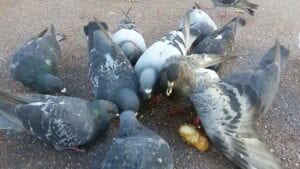
Some facts about pigeons:
• A pigeon aged between 1 and 30 days is called a squab
• A pigeon’s white feathers have no colour pigment
• Pigeons can see in colour, but can also see ultra-violet light – a part of the light spectrum that humans cannot see
• Most birds take a sip of water and throw their heads back so it trickles down their throat – pigeons suck up water like straws
• In the 16th century, pigeon poo was a highly valued commodity as it was a source of salt petre or Potassium nitrate – a main ingredient of gunpowder! In France, it was also used to fertilise vineyards
• In India, the pigeon post mail service stopped in 2004
• Cher Ami and GI Joe were two famous war hero pigeons…both saved the lives of many soldiers by carrying important messages across enemy lines
• Young pigeons remain in their nests for up to two months…which is why it is only pest controllers who often get to see them!
• Peregrine Falcons are a natural predator of the pigeon…they can dive at up to 200 miles per hour. A pigeon can dive at about 70 miles an hour.
Source
Pigeon Patrol Products & Services is the leading manufacturer and distributor of bird deterrent (control) products in Canada. Pigeon Patrol products have solved pest bird problems in industrial, commercial, and residential settings since 2000, by using safe and humane bird deterrents with only bird and animal friendly solutions. At Pigeon Patrol, we manufacture and offer a variety of bird deterrents, ranging from Ultra-flex Bird Spikes with UV protection, Bird Netting, 4-S Bird Gel and the best Ultrasonic and audible sound devices on the market today.
Voted Best Canadian wholesaler for Bird Deterrent products ten years in a row.
Contact us at 1- 877– 4– NO-BIRD, (604) 585-9279 or visit our website at www.pigeonpatrol.ca
Pigeon/Pigeon Patrol / Pigeons Roosting / Vancouver Pigeon Control /Bird Spikes / Bird Control / Bird Deterrent / Pigeon Deterrent? Surrey Pigeon Control / Pest /Seagull deterrent / Vancouver Pigeon Blog / Birds Inside Home / Pigeons in the cities / Ice Pigeons/ What to do about pigeons/ sparrows , Damage by Sparrows, How To Keep Raccoons Away, Why Are Raccoons Considered Pests/ De-fence / Pigeon Nesting/ Bird Droppings / Pigeon Dropping/ woodpecker control/ Professional Bird Control Company/ Keep The Birds Away/ Birds/rats/ seagull/pigeon/woodpecker/ dove/sparrow/pidgeon control/pidgeon problem/ pidgeon control/flying rats/ pigeon Problems/ bird netting/bird gel/bird spray/bird nails/ bird guard
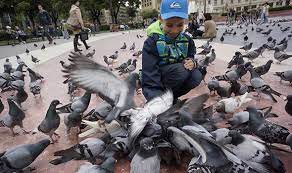
by Pigeon Patrol | Oct 5, 2021 | Pigeon Spikes, Pigeons, Pigeons in the News, Raccoons, Sparrows
Pigeons are stout-bodied birds that are common in large cities. The most common type of pigeon found in urban areas is the feral rock pigeon, which has a short neck and slender bill. Because pigeons procreate in large numbers, they have come under scrutiny in many cities, and the feeding of wild pigeons has become illegal in many urban settings. Pigeons require a very specific diet in order to maintain their health, so whether you’re feeding pigeons in the wild or in your own coup, you should be careful what you do and do not feed them.
Identification
In order to maintain a healthy diet for a pigeon, you must emulate the grain intake they would get in the wild. Avoiding foods normally reserved for people, like bread, cheese and meats. Wild pigeons eat a diet filled mainly with non-fiber items like grains and seeds. Bread is one of the most common foods that people feed to pigeons, but the complex carbohydrates in bread offer no nutritional value and could even work to starve them. Because pigeons do not have teeth, they require a supply of grit in order to digest their food. Pigeons digest and break down food through the use of the crop, which is a sack at the base of their throat and a gizzard, located at the bottom of the intestinal track. In order for this system to work, pigeons must eat small stones and rocks, along with their food, in order to survive. Wild pigeons will get the right amount of grit naturally when they gather grain and seeds, but domestic pigeons must be fed processed shell grit along with their normal diet.

Considerations
Foods required for a healthy pigeon include dried field peas and corn. They are high in protein and help build strong muscles and maintain a pigeons plumage. Corn, however, can store in a pigeon’s body as fat, so it should only be fed to a pigeon in limited quantities during the winter months. Wheat and sorghum are staple grains for wild pigeons and can also be found in domestic pigeon seed mixes. Some wild pigeons eat small quantities of green plants as well. A full-grown pigeon will eat about 500 g of grain each week.
Misconceptions
A common myth claims that eating uncooked rice will cause a pigeon to explode. The myth claims that pigeons are unable to digest the grain and when it expands in their stomachs, it has nowhere to go. In truth, birds often depend on flooded rice fields for feed while migrating north, and animal biology experts say that uncooked rice is no different than that which birds feed on in the wild.
Warning
Pigeons require much more water than most birds, especially during breeding season, so dehydrating foods should be avoided. Salt can dehydrate pigeons, but pigeons love salt, and will attack salt blocks reserved for pigs and sheep. Human food, especially meats, are very dangerous for a pigeon’s health. Human food can introduce bacteria to pigeons that they are not capable of fighting off. Diseases and health risks aside, feeding pigeons in the wild can make them dependent on human feeding and less likely to seek food on their own.
Potential
Human interaction and improper feeding of domestic and wild pigeons is believed to be one of the reasons for the birds’ decline. While many urban areas claim that pigeon populations are out of control, the truth is that around 59 species are currently threatened by extinction, which is over 20 percent of the pigeon population. Since the 1600s, 10 species of pigeon have become extinct. While habitat loss and over-hunting are partly to blame, bird specialists believe that domestication and improper feeding has weakened the entire species.
Source
Pigeon Patrol Products & Services is the leading manufacturer and distributor of bird deterrent (control) products in Canada. Pigeon Patrol products have solved pest bird problems in industrial, commercial, and residential settings since 2000, by using safe and humane bird deterrents with only bird and animal friendly solutions. At Pigeon Patrol, we manufacture and offer a variety of bird deterrents, ranging from Ultra-flex Bird Spikes with UV protection, Bird Netting, 4-S Bird Gel and the best Ultrasonic and audible sound devices on the market today.
Voted Best Canadian wholesaler for Bird Deterrent products ten years in a row.
Contact us at 1- 877– 4– NO-BIRD, (604) 585-9279 or visit our website at www.pigeonpatrol.ca
Pigeon/Pigeon Patrol / Pigeons Roosting / Vancouver Pigeon Control /Bird Spikes / Bird Control / Bird Deterrent / Pigeon Deterrent? Surrey Pigeon Control / Pest /Seagull deterrent / Vancouver Pigeon Blog / Birds Inside Home / Pigeons in the cities / Ice Pigeons/ What to do about pigeons/ sparrows , Damage by Sparrows, How To Keep Raccoons Away, Why Are Raccoons Considered Pests/ De-fence / Pigeon Nesting/ Bird Droppings / Pigeon Dropping/ woodpecker control/ Professional Bird Control Company/ Keep The Birds Away/ Birds/rats/ seagull/pigeon/woodpecker/ dove/sparrow/pidgeon control/pidgeon problem/ pidgeon control/flying rats/ pigeon Problems/ bird netting/bird gel/bird spray/bird nails/ bird guard
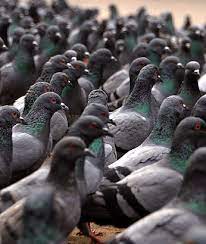
by Pigeon Patrol | Oct 5, 2021 | Pigeon Predators, Pigeon Spikes, Pigeons, Pigeons in the News, Raccoons, Sparrows, UltraSonic Bird Control
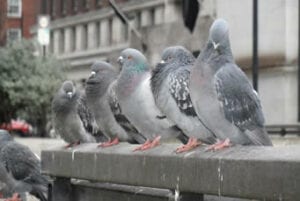
Pigeons are a successful and adaptable group of birds that thrive in varied habitats. Most of the pigeons commonly seen in cities in the United States are feral rock doves (Columba livia), descendants of birds first brought to America from Europe in the 1600s. Sometimes also called rock pigeons, these birds make their homes in a variety of habitats throughout the world, but many have adapted to life with humans.
Urban Landscapes
Pigeons thrive in cities where humans create buildings that pigeons are able to adapt for their own use. Tall buildings and window ledges simulate the natural cliffs where wild pigeons live, and the birds use these man-made spots to roost, loaf and build their nests. City birds scavenge from the trash and from pet food dishes left outside, and they will pick up any dropped bits of food that they find. It’s also common for people to feed city pigeons bits of bread, crumbs and birdseed.
Rural and Suburban Pigeons
Cities aren’t the only place that pigeons can thrive. Where in the wild they might have used cliffs and caves, in rural and suburban areas pigeons are quick to move into open barns and abandoned homes, under bridges and around other available human structures. They eat spilled grain, garden waste and animal food, as well as any other foods that present themselves. These birds sometimes make a nuisance of themselves by living and feeding around farms and grain storage elevators.
Rocky Cliffs
In the wild pigeons often live on or near large, rocky cliffs. They typically build their nests on the faces of these cliffs, presenting a challenge to many would-be predators. Pigeons also live inside caves, near the opening, when these are available. In the wild they mostly eat seeds and grains, but will also eat fruit, insects, slugs, snails and even small lizards. Both parents take turns incubating the eggs, and it’s not uncommon for pigeons to return to the same nest year after year, making a new nest on top of the old one.
Other Pigeon Habitats
Pigeons live in almost every part of the world. They inhabit forests such as rainforests, temperate deciduous forests, swamp forests and arboreal forests. Pigeons inhabit desert areas where the get water by eating succulent plants, and they also live on islands, in mangrove forests, in chaparral and in almost every other environment on Earth. The only places where pigeons haven’t settled in are the high Arctic and Antarctic regions. In areas where food is plentiful and the environment is favorable, pigeons may live in groups of hundreds or even thousands of birds.
Source
Pigeon Patrol Products & Services is the leading manufacturer and distributor of bird deterrent (control) products in Canada. Pigeon Patrol products have solved pest bird problems in industrial, commercial, and residential settings since 2000, by using safe and humane bird deterrents with only bird and animal friendly solutions. At Pigeon Patrol, we manufacture and offer a variety of bird deterrents, ranging from Ultra-flex Bird Spikes with UV protection, Bird Netting, 4-S Bird Gel and the best Ultrasonic and audible sound devices on the market today.
Voted Best Canadian wholesaler for Bird Deterrent products ten years in a row.
Contact us at 1- 877– 4– NO-BIRD, (604) 585-9279 or visit our website at www.pigeonpatrol.ca
Pigeon/Pigeon Patrol / Pigeons Roosting / Vancouver Pigeon Control /Bird Spikes / Bird Control / Bird Deterrent / Pigeon Deterrent? Surrey Pigeon Control / Pest /Seagull deterrent / Vancouver Pigeon Blog / Birds Inside Home / Pigeons in the cities / Ice Pigeons/ What to do about pigeons/ sparrows , Damage by Sparrows, How To Keep Raccoons Away, Why Are Raccoons Considered Pests/ De-fence / Pigeon Nesting/ Bird Droppings / Pigeon Dropping/ woodpecker control/ Professional Bird Control Company/ Keep The Birds Away/ Birds/rats/ seagull/pigeon/woodpecker/ dove/sparrow/pidgeon control/pidgeon problem/ pidgeon control/flying rats/ pigeon Problems/ bird netting/bird gel/bird spray/bird nails/ bird guard
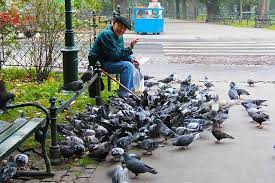
by Pigeon Patrol | Sep 28, 2021 | Pigeon Spikes, Pigeons, Pigeons in the News, Raccoons, Sparrows, UltraSonic Bird Control
A ban on feeding Venice’s famed flocks of pigeons took effect Wednesday. It’s an attempt to control the burgeoning number of birds blamed for spreading filth and ruining the city’s monuments.
Please don’t feed the pigeons.
A ban on feeding Venice’s famed flocks of pigeons took effect Wednesday. Nineteen pigeon-feed sellers on St. Mark’s Square immediately went out of business. They had long been granted licenses to sell packages of dried corn to tourists wanting snapshots of themselves covered with the birds.
A spokeswoman in Venice said people who feed the pigeons face fines from $80 to $775.
Mayor Massimo Cacciari pushed for the ban in an attempt to control the burgeoning number of pigeons blamed for spreading filth and ruining the city’s glorious facades and monuments.
The pigeon-feed sellers, who said they have been selling their wares on St. Mark’s Square for a century, remained up in arms and protested the ban with placards on their booths aimed at the mayor, including: “Curse the day I voted for you” and “Cacciari, what kind of Venetian are you?”
Source
Pigeon Patrol Products & Services is the leading manufacturer and distributor of bird deterrent (control) products in Canada. Pigeon Patrol products have solved pest bird problems in industrial, commercial, and residential settings since 2000, by using safe and humane bird deterrents with only bird and animal friendly solutions. At Pigeon Patrol, we manufacture and offer a variety of bird deterrents, ranging from Ultra-flex Bird Spikes with UV protection, Bird Netting, 4-S Bird Gel and the best Ultrasonic and audible sound devices on the market today.
Voted Best Canadian wholesaler for Bird Deterrent products ten years in a row.
Contact us at 1- 877– 4– NO-BIRD, (604) 585-9279 or visit our website at www.pigeonpatrol.ca
Pigeon/Pigeon Patrol / Pigeons Roosting / Vancouver Pigeon Control /Bird Spikes / Bird Control / Bird Deterrent / Pigeon Deterrent? Surrey Pigeon Control / Pest /Seagull deterrent / Vancouver Pigeon Blog / Birds Inside Home / Pigeons in the cities / Ice Pigeons/ What to do about pigeons/ sparrows , Damage by Sparrows, How To Keep Raccoons Away, Why Are Raccoons Considered Pests/ De-fence / Pigeon Nesting/ Bird Droppings / Pigeon Dropping/ woodpecker control/ Professional Bird Control Company/ Keep The Birds Away/ Birds/rats/ seagull/pigeon/woodpecker/ dove/sparrow/pidgeon control/pidgeon problem/ pidgeon control/flying rats/ pigeon Problems/ bird netting/bird gel/bird spray/bird nails/ bird guard
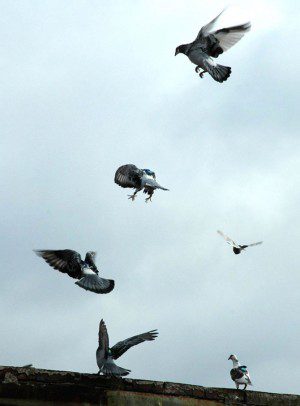
by Pigeon Patrol | Sep 28, 2021 | Pigeon Spikes, Pigeons, Pigeons in the News, Raccoons, Sparrows, UltraSonic Bird Control
A pilot study to see if feeding pigeons birth control can lower their numbers at Vancouver’s SkyTrain stations has expanded to include eight stations in the region.
The program works by installing a feeder and a camera on TransLink property at stations where there’s a pigeon problem. The feed contains OvoControl, a product that interferes with birds’ eggs’ ability to hatch.
As the birds who call the stations home die of natural causes, researchers and TransLink staff hope there won’t be as many young birds to take their place, and pigeon numbers will decrease over time.
“We think TransLink can be a real leader in humane wildlife control,” Sara Dubois, the BC SPCA’s chief scientific officer, told Daily Hive in a phone interview.
“We’re trying to manage them in a way that’s safe for them and for trains.”
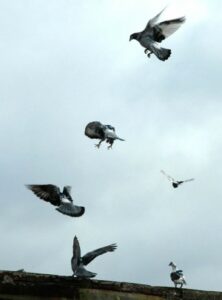
Dubois and the UBC graduate students she’s working with installed the first feeder in January 2019.
Now, the program has been expanded to include eight stations for the study. Four stations feed birds OvoControl, and the other four contain regular food. Over time, the researchers will see whether the birth control significantly reduces pigeon flocks at stations.
It’s still possible for new birds to travel to the stations, Dubois said. But if they stay and eat the birth control consistently, their reproductive abilities will soon be curbed as well.
Pigeons have long caused problems for the transit authority, because their presence on tracks can stop trains and delay customers. Staff also have to spend time cleaning up their excrement from platforms.
Dubois recounted one incident where a pigeon nest caught on fire and service on the Expo Line had to be stopped for several hours.
Previously, TransLink has installed spikes and netting to keep pigeons out, but those methods haven’t been effective. Dubois doesn’t want to see the birds killed, and sees using birth control as an effective way to keep pigeons safe and trains moving.
TransLink and the BC SPCA aren’t revealing which stations have the birth control feeders so that the equipment doesn’t get vandalized. Dubois said that earlier this year they already had one camera and feeder go missing.
If the birth control proves effective, Dubois says it could be a relatively cheap way to reduce the number of birds causing SkyTrain problems.
“It’s really inexpensive compared to the cost of maintenance, cleaning, and trains being down,” she said.
Source
Pigeon Patrol Products & Services is the leading manufacturer and distributor of bird deterrent (control) products in Canada. Pigeon Patrol products have solved pest bird problems in industrial, commercial, and residential settings since 2000, by using safe and humane bird deterrents with only bird and animal friendly solutions. At Pigeon Patrol, we manufacture and offer a variety of bird deterrents, ranging from Ultra-flex Bird Spikes with UV protection, Bird Netting, 4-S Bird Gel and the best Ultrasonic and audible sound devices on the market today.
Voted Best Canadian wholesaler for Bird Deterrent products ten years in a row.
Contact us at 1- 877– 4– NO-BIRD, (604) 585-9279 or visit our website at www.pigeonpatrol.ca
Pigeon/Pigeon Patrol / Pigeons Roosting / Vancouver Pigeon Control /Bird Spikes / Bird Control / Bird Deterrent / Pigeon Deterrent? Surrey Pigeon Control / Pest /Seagull deterrent / Vancouver Pigeon Blog / Birds Inside Home / Pigeons in the cities / Ice Pigeons/ What to do about pigeons/ sparrows , Damage by Sparrows, How To Keep Raccoons Away, Why Are Raccoons Considered Pests/ De-fence / Pigeon Nesting/ Bird Droppings / Pigeon Dropping/ woodpecker control/ Professional Bird Control Company/ Keep The Birds Away/ Birds/rats/ seagull/pigeon/woodpecker/ dove/sparrow/pidgeon control/pidgeon problem/ pidgeon control/flying rats/ pigeon Problems/ bird netting/bird gel/bird spray/bird nails/ bird guard










